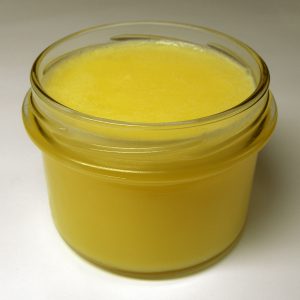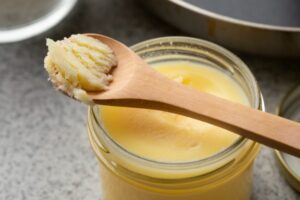What’s the first thing people tell you when it comes to diet and acne?
AVOID DAIRY!
In 99% of cases, this is pretty good advice. I wrote an entire article on why dairy is a nightmare for acne here, but in summary:
- Dairy is high in hormones, including IGF-1 and insulin. They block pores, make your skin produce too much oil, and trigger inflammation (which causes pimples)
- Dairy makes your body produce a ton of insulin (an acne-causing hormone) on top of the hormones it already contains. That’s double trouble for your skin!
- Dairy protein (casein) can damage the gut and make digestion difficult
- Dairy contains a lot of calcium, which can actually make acne worse
- Sensitivity to lactose, casein, and whey are extremely common, affecting upwards of half the world population
Okay, okay, okay, we get it, dairy clearly isn’t the best for your skin.
But if dairy’s so bad for your skin, then why do I recommend grass-fed ghee butter in the GoodGlow Diet Blueprint.
That’s exactly what we’re going to talk about in this article.
What is Ghee (Clarified Butter)?
Some of you might not even know what I’m talking about when I say “ghee”.

Ghee, or clarified butter, is essentially butter minus all the “bad” stuff.
Butter contains milk solids, which means it has trace amounts of lactose and casein. A lot of people are sensitive to both lactose and casein. This damages the gut and triggers inflammation – both problems for those with acne-prone skin.
Ghee luckily doesn’t contain lactose or casein.
Ghee is made by simply simmering butter at a high temperature, waiting for the milk solids to caramelize and impurities to boil off, and then straining the pure fat that remains.
What you’re left with is basically 100% pure butterfat – no lactose, no casein, no whey.
Ghee is grainy and a little more nutty-tasting than regular butter, but all and all I wouldn’t say they’re too different in taste and texture.
Why is ghee safe for acne-prone skin?
As I mentioned above, when you make ghee you remove all the milk solids from butter. By doing this, you eliminate any trace lactose or casein from the butter.
Ghee isn’t just safe for your skin, it actually contains some vitamins and minerals that are beneficial for acne too, including vitamin A, D, E, and K.
What does this mean for your skin?
- It means that even if you’re sensitive to most dairy, you should be able to handle ghee just fine
- Because there are virtually no carbohydrates or protein in ghee, it won’t trigger any insulin, an acne-causing hormone
- Very low in omega-6 fatty acids, which can trigger inflammation (which leads to red, angry, inflamed pimples!)
- Extra vitamin A – vitamin A is one of the single most important nutrients for clear skin. It helps with wound healing, antioxidant functioning, skin oil regulation, and proper shedding of skin cells (there’s a reason grass-fed beef liver is our #1 recommended natural supplement for clear skin)
On top of these factors, ghee is also an extremely shelf-stable and heat-stable fat.
Ghee is good at room temp for months at a time, and even longer in the fridge Ghee is also safe for high-heat cooking. It has a smoke point of over 450°F, which means it won’t oxidize (go bad) at high temps like other fats or oils.
Despite all this good stuff, there is one caveat: not all ghee is created equal.
The wrong type of ghee might still give you acne.
Why low-quality ghee can make you break out
Conventional dairy cows are raised in factory farm environments.
They are fed a diet of corn, wheat, and soy (all acne-causing foods), and forced to stay in extremely confined spaces.
The end result is a huge cow with a ton of hormones and toxins loaded inside it.
Don’t take my word for it, there is plenty of evidence out there that factory-farmed cows differ from grass-fed cows in their nutritional profile.
Grain-fed cows are:
- Higher in inflammatory omega-6 fatty acids – a recipe for acne
- Lower in anti-inflammatory, healthy omega-3 fatty acids that fight chronic inflammation
- Many grain-fed cows are given antibiotics, which can disrupt your gut and cause acne
- Have less vitamin A, a crucial nutrient for clear skin
If you’re eating ghee from conventional butter and still getting acne, this could be the reason why.
On the flip side, grass-fed and grass-finished beef is among the healthiest meat you could eat, and luckily it’s becoming more and more affordable to go grass-fed.
Where can I buy grass-fed ghee?
There’s two options when it comes to getting high-quality ghee:
- Make it yourself
- Buy pre-made, organic grass-fed ghee online or at a local health foods store
I’ve done both, and the end result with each is about the same.
I personally really like 4th & Heart Himalayan Pink Salt Grass-Fed Ghee Butter.

I recommend 4th & Heart for a few reasons:
- Sourced from grass-fed and grass-finished cows in New Zealand
- Antibiotic and hormone-free
- Cooked via traditional methods
- The “Himalayan Pink Salt” flavor tastes incredible.
I’ve used it in Bulletproof Coffee and pretty much any dish that involves cooking. On occasion, I’ll just eat spoonful or two of it plain.
How to Make Your Own Ghee
You can also make your own ghee if you’re trying to save money or have a solid grass-fed butter supply.
If you have a Trader Joe’s near you, load up on Kerrygold Butter. Not only is Kerrygold affordable for the quality (~$3/stick), but it’s grass-fed, grass-finished, and organic butter from Ireland.
Making ghee is crazy simple, all you need is butter, a pot, a cheesecloth or filter, and something to put the ghee in when you’re done.
Here’s how I make ghee (or check out the video below):
- Put 2-4 sticks of butter in a pot and heat on medium
- Wait 20-25 minutes until butter is 260°F+ (if you don’t have a thermometer, check the bottom of the pan for browned milk solids)
- Let the ghee cool for 5 minutes
- Scrape off any white cream from the top that you can
- Pour the melted ghee through a cheesecloth and into your mason jar or container
Congrats, you just made ghee!
Putting it all together
Dairy can be a real problem for your skin:
- It contains hormones that cause acne (IGF-1 & insulin)
- When you eat dairy, your body releases even more acne-causing hormones (insulin)
- Dairy intolerance is extremely common
Ghee gets around these issues by being pure butterfat. However, low-quality ghee from grain-fed cows may still contain antibiotics, hormones, and omega-6 fatty acids that cause acne.
For this reason, it’s crucial to get high-quality ghee, either made at home from high-quality butter (Kerrygold is the best) or online through a high-quality supplier.
All-and-all, grass-fed ghee is among the safest fats out there for your skin.
Be careful though – everyone is different. Even the trace amounts of dairy hormones may trigger acne in certain individuals. Listen to your body and trust your instincts – ghee might not be for you.
Frequently Asked Questions
No, ghee does not cause acne. In fact, ghee has lots of nutrients including vitamins A, K, E, and omega-3 fatty acids that help with the production of collagen.
No, ghee is not comedogenic. Because it does not contain lactose ghee can actually be used as a non-comedogenic.

